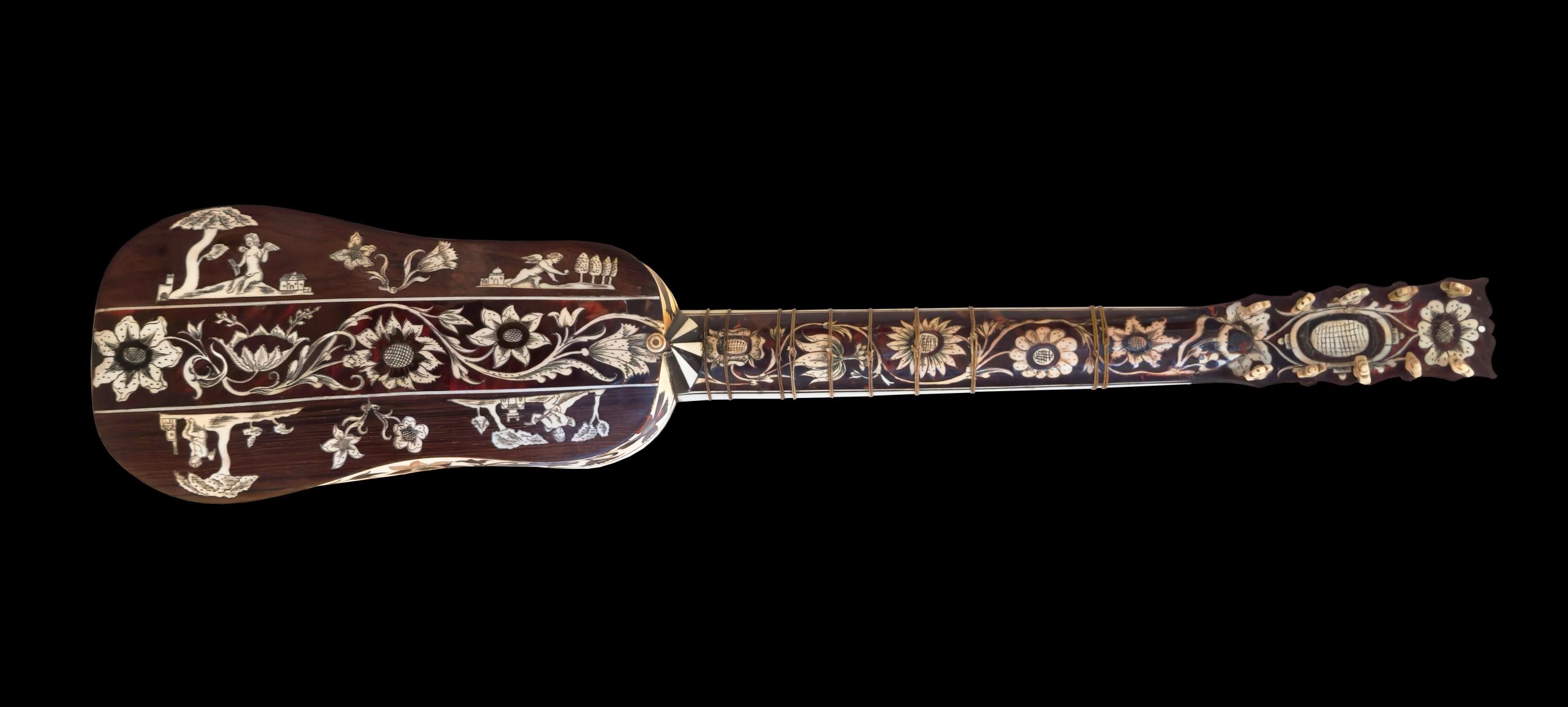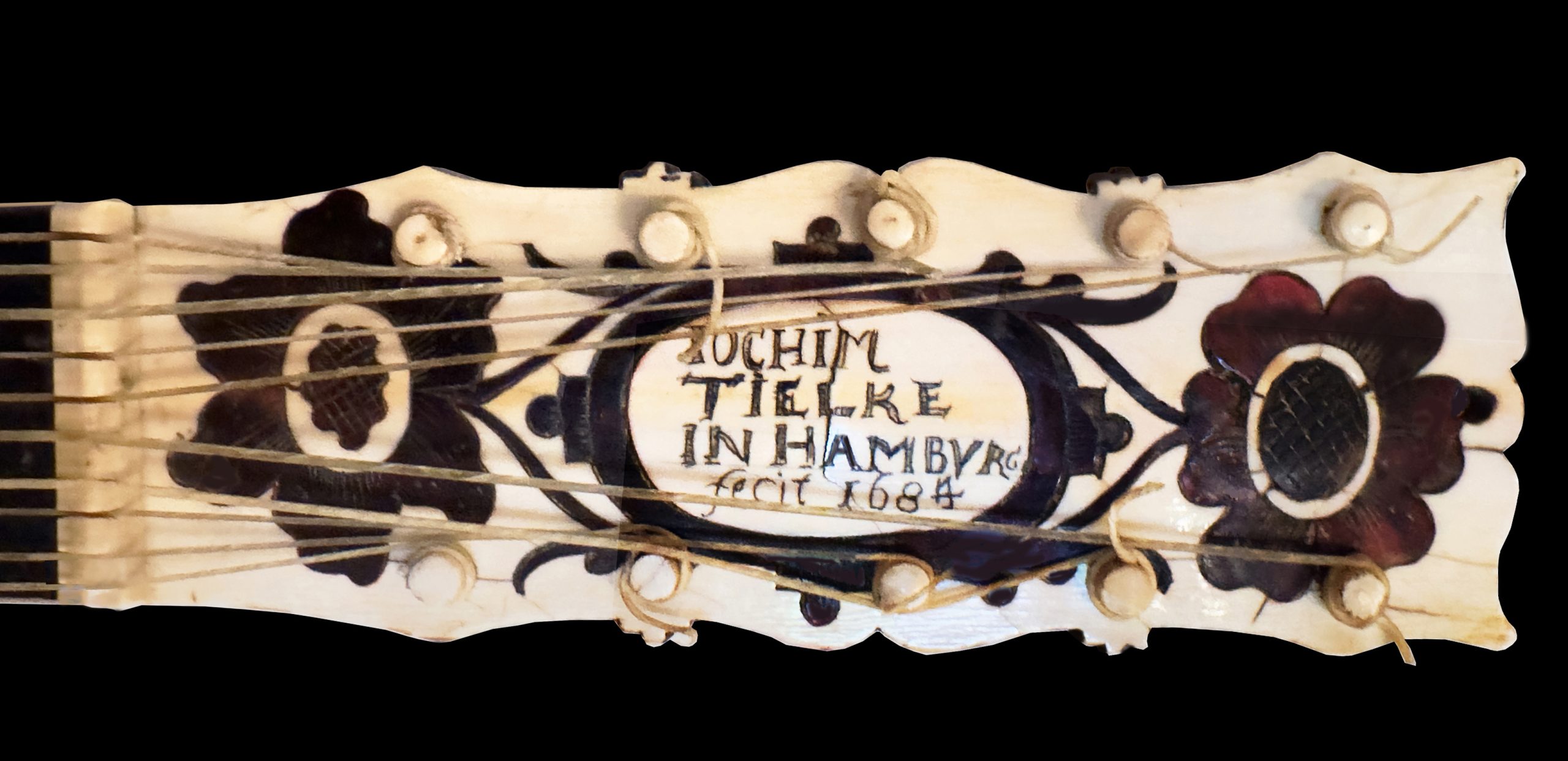Joachim Tielke (1641–1719) of Hamburg is universally recognized as one of the four leading guitar makers of the seventeenth and early eighteenth centuries, standing alongside Sellas of Venice, the Voboams of Paris, and Stradivari of Cremona. In addition to guitars (27 extant), his surviving output includes 5 violins, a single violincello, 10 lutes, 7 theorbos, 6 viola d’amores, 92 viola da gambas, 8 citterns, 4 pochettes, 4 barytons, 3 mandoras, and 5 angéliques – for a total of 172 musical instruments.
| Specifications | |
| Date | 1684 |
| Location | Hamburg, Germany |
| Length of Guitar | 620mm |
| String Length | 433mm |
| Upper Bout Width | |
| Waist Width | |
| Lower Bout Width | |
| Side Depth at Waist | |
| Soundboard: Yew | Back: Rosewood, ivory, & tortoiseshell | Sides: ivory & tortoiseshell | Details: Adorned with emblematic scenes and floral marquetry in ivory and tortoiseshell. | |


Born in Königsberg, Prussia (known today as Kaliningrad in the Russian Federation) on October 14, 1641, little is known about Tielke’s early years, but evidence suggests he was born into a musical instrument making family. It has been established that he attended the renowned University of Leiden in the Netherlands in 1663, initially studying medicine but later turning to philosophy and the fine arts.
In 1667, Tielke traveled to Hamburg, a cultural nexus in the seventeenth century for musical creativity that included such luminaries as the organist-composer, Dieterich Buxtehude, an influencer of Johann Sebastian Bach and George Frideric Handel. Tielke went to work for his future brother-in-law, luthier Hans Christoffer Fleischer (1638-1692?) and two years later established his own workshop, eventually supervising a team of expert craftsmen and contracting with several business partners. He went on to become a leading manufacturer of musical instruments, and his decorative objets d’art were in high demand by wealthy patrons and the nobility.
Tielke’s time spent in Leiden exposed him to the artwork found in Otto van Veen’s Armorum Emblemata (Emblems of Love – 1608), a series of epigrams with engravings depicting figures from Greco-Roman mythology. Influenced by Veen, Tielke masterfully carved on the necks and backs of many of his instruments emblematic scenes interspersed with floral ornaments using ivory, tortoiseshell, mother of pearl, and ebony. Tielke is also known for his use of reverse inlay or intarsia, where two instruments would have the same decorative inlay pattern but in reverse. This was created by using contrasting materials, e.g., ivory where there is ebony on one and ebony where there is ivory on the other.
Inspired by Veen’s engravings, the slightly domed back of the Tielke guitar in the Austin-Marie Collection has four allegorical scenes carved in ivory. Each scene features a cherub posing in an epigrammatic visual expression. Tielke’s use of floral marquetry carved of ivory and inlaid in tortoiseshell embellishes the center rib of the back and continues up the neck to the top of the headstock. The sides are plated with ivory inlaid with floral tortoiseshell motifs. The 10 carved ivory tuning pegs accommodating five courses are tapered in length, ostensibly to allow for easier tuning. Inlaid into the headstock is the attribution, “JOCHIM TIELKE IN HAMBURG fecit 1684.” A label on the inside of the back reads the same (although here Tielke’s first name is spelled “Joachim”). The soundboard is made of yew and the top and neck bindings are made of ebony and ivory. The nut and bridge have been replaced and the period-correct gilded rose is a replica crafted by British luthier Alexander Batov of an original rose from a Tielke bell cittern on display at the Victoria and Albert Museum, London. Some experts have suggested the diminutive Tielke guitar in this collection is a “child’s guitar,” although there is no evidence in the historical record to confirm this was the intent. With a string length of 433 mm and a total length of just 620 mm, this instrument may have functioned as the highest voice in an ensemble.
Tielke’s work represents the apex of achievement and perfect synthesis of late seventeenth-century visual and musical art.